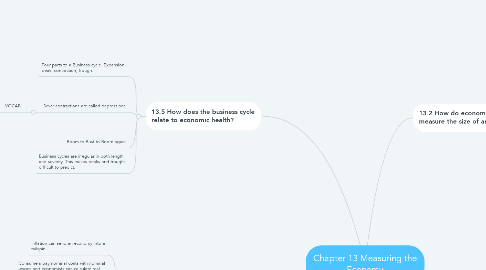
1. 13.4 What does the inflation rate reveal about an economy's health?
1.1. Inflation can send an economy into a tailspin
1.2. Consumers pay nominal costs with nominal wages and economists can calculate real wages and compare them over time.
1.3. Increase in demands results in demand pull inflation and increase in cost resulted by cost push inflation
1.3.1. Vocab
1.3.1.1. Nominal cost of living: The cost in current dollars of all the basic goods and services needed by the average consumer.
1.3.1.2. Real cost of living: The cost in constant dollars of all the basic goods and services needed by the average consumer; the nominal cost of living adjusted for inflation
1.4. BLS relies on the consumer price to estimate the level of inflation in the US. CPI may make reported inflation rate less than accurate
2. 13.5 How does the business cycle relate to economic health?
2.1. Four parts to a Business cycle. Expansion, peak, contraction, trough.
2.2. Sever contractions are called depressions
2.2.1. VOCAB
2.2.1.1. Business cycle: A reoccurring pattern of growth and decline in economic activity over time
2.2.1.2. Recession: A period of declining national economic activity, usually measured as a decrease in GDP for at least two consecutive quarters
2.3. Boom to Bust to Boom again
2.4. Business cycles are irregular in both length and severity. This makes peaks and troughs difficult to predict.
3. 13.2 How do economists measure the size of an Economy?
3.1. GDP is a good sign of economic health. GDP (Gross domestic product) is the market value of all final goods produced within a country given a period of economic output.
3.2. Nominal VS Real GDP. Nominal measures the output of an economy valued at today's prices, or in current dollars. Real measures the output of an economy not in current dollars but in constant dollars
3.2.1. Vocab
3.2.1.1. GDP (Gross domestic product) is the market value of all final goods produced within a country given a period of economic output.
3.2.1.2. Current dollars: the value of a dollar in the year it is spent; a measure of the dollar's value that reflects current purchasing power, without taking inflation into account
3.2.1.3. Constant dollars: the value of the dollar fixed at a specified based year; a measure of the dollar's value adjusted for inflation to reflect purchasing power over time
3.3. Per Capita GDP, as a country's per capita GDP increases, so do other factors of well-being
3.4. GDP Growth makes people better off.
4. 13.3 What does the unemployment rate tell us about an economy's health?
4.1. Unemployment rate is a good indactor of a healthy economy. Generally a high unemployment rate means the overall health of the economy is poor.
4.2. Four types of Unemployment: frictional, structural, seasonal, and cyclical
4.3. When an economy reaches full employment, jobs exist for people who want to work, even though a certain percentage of those jobs and workers will not have yet been matches together, economist call this percent natural rat of unemployment
4.3.1. Vocab
4.3.1.1. Discouraged workers: unemployed workers who have ceased to look for work; discouraged workers are not considered part of the labor force and are not factored into the unemployment rate
4.3.1.2. Involuntary part-time workers: people who settle for part-time employment because they are unable to find full-time work
4.3.1.3. Underground economy: Sector of the economy based on illegal activities, such as drugs dealing and unlawful gambling
